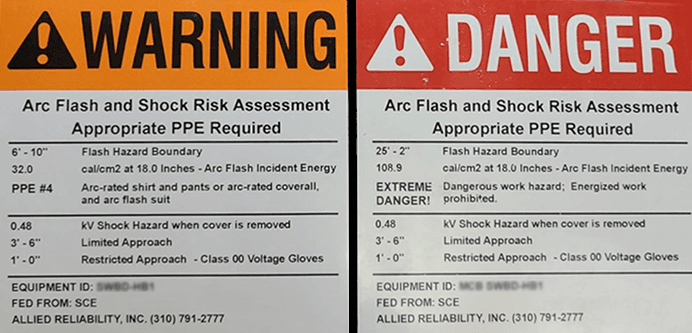Some background items are required to perform an arc flash assessment of the electrical system. First and foremost is an updated single-line or one-line drawing (SLD). A single-line drawing is an electrical schematic of the facility's electrical system. This should include all switchgear, switchboards, panelboards, transfer switch equipment (automatic or manual), uninterruptible power systems (UPS), transformers, motors, variable speed drives (VFDs) or adjustable speed drives (ASDs), disconnecting devices. In addition, information on conductors, e.g., size, number, lengths, and supporting mechanisms (tray, conduit, air), is also required. Information is also required on the service transformers and protective devices used by the electrical utility that feeds your facility.

Arc Flash Assessments: Why and When Are They Required?
For employees to work on exposed live (energized) circuits, an arc flash hazard assessment is needed to determine the incident energy available at the equipment and what personal protective equipment (PPE) is needed to work safely.


Overcurrent protective devices, e.g., circuit breakers and fuses, are also required. For information required for fuses, include class, ampere rating, manufacturer, and type. For circuit breakers, the information required includes Manufacturer, Type of breaker (LVPB, ICCB, MCCB), trip type (thermal-magnetic, electronic), and all associated settings.
Once the single-line drawing is complete, an electrical model can be constructed. While standards allow for hand calculations or simulations, hand calculations can become cumbersome. Once the model is constructed, arc flash hazard analysis can be conducted. Standard simulation tools are available from SKM, ETAP, and EasyPower.
The analytical techniques used to conduct an arc flash hazard analysis are described in IEEE Guide for Performing Arc-Flash Hazard Calculations, IEEE 1584, and the Standard for Electrical Safety in the Workplace, NFPA7OE. There are minimal differences between the model calculations.
The arc flash analysis of the electrical system in the facility will provide the following outputs:
- Arc flash boundary
- Incident energy
- Shock hazard voltage
- Shock hazard boundaries
- Limited approach boundary
- Restricted approach boundary
- Prohibited approach boundary
Once the arc flash hazard assessment has been conducted, all equipment is labeled, and personnel are trained to work safely around energized circuits. Additionally, the Standard for Electrical Safety in the Workplace, NFPA 7OE states in Article 130.5 that an arc flash assessment needs to be reviewed every five years or whenever there is a significant change in the electrical system. The five-year interval is a straight-forward requirement.
Determining a significant change can be left up to interpretation. Whenever there are changes to the electrical system, the single-line diagram must be updated, and the arc flash hazard analysis needs to be reviewed. While adding small motors or new equipment may not affect the arc flash boundaries or incident energy of existing equipment, you will need this information to label the new equipment.

Major changes to the electrical system, e.g., new electrical service, the addition of large motors, facility expansions, etc., can result in the amount of incident energy at existing equipment. This can require updating all equipment labeling, and re-training employees who work on exposed live (energized) circuits. Even if there are no changes in the electrical system, a review of the arc flash hazard analysis is required at least every five years [1].
The review of the arc flash hazard analysis should be conducted formally. This requires documentation. Documentation can include reports of the analysis, meeting notes, and process reviews associated with any change management system used by your organization. I recommend keeping all quality documentation related to the arc flash hazard review on file for at least three cycles - the current arc flash hazard analysis plus the past two arc flash hazard analyses.
References:
1. National Fire Protection Association (NFPA). Standard for Electrical Safety in the Workplace, NFPA 70E-2018. Quincy, MA USA
About the Author
Michael Levitt

In his current role, Michael Levitt is the general manager of Allied Reliability’s electricals division and is certified in all the competencies they represent.
Michael has more than 30 years’ experience in designing equipment, systems, and performing testing on power distribution systems, power distribution equipment, and associated components.
Connect with Michael on LinkedIn.
ABOUT ALLIED RELIABILITY
Allied Reliability provides asset management consulting and predictive maintenance solutions across the lifecycle of your production assets to deliver required throughput at lowest operating cost while managing asset risk. We do this by partnering with our clients, applying our proven asset management methodology, and leveraging decades of practitioner experience across more verticals than any other provider. Our asset management solutions include Consulting & Training, Condition-based Maintenance, Industrial Staffing, Electrical Services, and Machine Reliability.
Subscribe to our Blog
Receive the latest insights on reliability, maintenance, and asset management best practices.